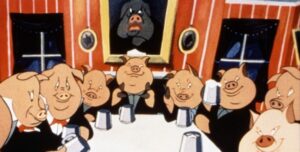It is a drab Wednesday in April and I am sat naked in a transparent plastic shed. Tucked away in a forest near the sleepy town of Uckfield, a woman starts to hit me in the face with some birch twigs, while another incants tales of Sussex’s dragons. “Beware the dragons of St Leonard’s Forest,” she wails. “They’re not like the winged dragons of Wales. These ones are like serpents, slithering and squirting a deadly and smelly slime that torments the people of Horsham.”
The woman thrashing me pauses to throw a ladleful of eucalyptus-infused water onto a sauna stove. There is a hiss, and steam clouds the room. “Beware the puddles, for they are fiery intra-planetary cauldrons, used by the Sussex dragons to travel to Australia,” chants the English siren. Outside, a hip Canadian woman chops wood to sensuous French-Malian rock-kora fusion playing from a portable speaker. Others are busy at work, sweeping and carefully preparing the enchanted sauna ceremony.
My birch-twig attacker is Jamie, the ethereal saunameister of this spa-start-up-cum-pagan-temple. In a previous life, Jamie was a MacBook-using, flat white-sipping hipster photographer from east London, growing slowly disillusioned with the pressure and precarity of the city’s gentrification. Then, one day, while hungover at a music festival, she stumbled upon a sauna. “I came out of the sauna into nature and plunged into a cold lake and was reborn,” she says.
Months later, Jamie left London, moved to Sussex and set up her first sauna venture. After just five years, she’s flourishing: “I’ve created a really beautiful life for myself. I live on the beach, I work in a forest, I run my own business. I’m doing work that feels purposeful and impactful.”
In this, Jamie’s rebirth is far from unique. Quite the opposite: she is part of a vanguard rejecting the refined hedonism of the globalised Brooklyn-Shoreditch urban creative class. Suffocated by the downward mobility induced by our neo-feudal economy and its spiritually malnourished consensus, Jamie is part of an emergent socio-economic class — the Bohemian Peasantry, or Bopeas for short.
The Bopeas are a new paradigm in culture and consumption. They are the descendants of other post-war consumer groups: the Hippies, the Yuppies, and the Bobos of Soho House. However, unlike their predecessors, who grew from the boom of generational upward mobility and urbanisation in the 80 years after the Second World War, the Bopeas are responding to something else: a crisis of what Peter Turchin calls “elite overproduction” — and a diminishing need for everyone to be an urban creative.
For the past year, I have been investigating and decoding the experience of the downward mobility of the elite-aspirant creative class across the United Kingdom, the United States, Germany, and China. As part of a collective of social scientists, I have been exploring optimistic alternative responses to widespread disenchantment. Contrary to the depressing “opting-out” tales of global NEETs, hikikomori and the Great Resignation, I studied people and communities finding new ways to live a fulfilling life within society.
Like the rest of their generation, the Bopeas were bred to chase a particular vision of the good life, but they now know they cannot replicate their parent’s lifestyles — waiting until their deaths to inherit. Thomas Piketty calls this the return to the “inheritance society” that has been the norm for most of history. Steve Bannon puts it more bluntly: they are “nothing but 19th-century Russian serfs. They’re better fed; they’re better clothed; they’re in better shape; they have more information than anybody in the world at any point in time, but they don’t own anything.”
Yet rather than succumbing to the doom and gloom or burning themselves out by hustling, Bopeas are developing new ways to build a life. They cultivate meaning and status in ways that expand the ideals of success beyond conventional material accumulation and instantly decaying “cool”. Moreover, while this modern serfdom may not be able to accrue capital, Bopeas are spoiled for choice in a consumer universe built by brands. They can’t buy houses in the city, but they do have disposable income and a clear idea of “how to spend it”.
But what are Bopeas? The Bopeas are diverse in demographics and geography, but united by a shared mindset. Like the creative class that now dominate our culture, they draw inspiration from the bohemian ethos of artistry, non-conformity and self-expression. At the same time, however, they are wary of the narcissistic excesses of bohemianism, and enjoy a neo-medieval peasant worldview rooted in community values, rituals and natural rhythms.
The Bopeas don’t wear a uniform. There is no universal white sneaker choice and craft-beer calling card. Instead, it’s all about the niche, the hyper-local and the mythic. While they might be wearing an expensive French worker’s jacket bought from a nose-to-tail restaurant, they are more easily spotted by their deeds and search for harmony. Unlike their success-obsessed Yuppie and Bobo ancestors, Bopeas want to flourish holistically. They want to feel deeply in tune with their bodies and the world. They are the wild swimmers, the sauna obsessives, and the knitting, foraging and fermenting revivalists. They’re the ones rewilding our forests and guts. They are already shaping elite culture — they’re the reason the Financial Times wants you to buy £1,225 Givenchy cargo gardening trousers.
In essence, Bopeas opt for enchantment over refinement. In an algorithmic meat market of homogenous aesthetics and lifestyles, Bopeas differentiate themselves through their intentional cultivation of harmony. While Bopeaism incarnates in individuals — Paul Kingsnorth is perhaps the Bopea made flesh — it is also an aspirational mindset. During the Covid lockdowns, for instance, many of us transfigured into sourdough Bopeas.
The Bopeas I studied are essentially united by a desire to nurture genuine connection and finding meaning in life. They care about wider societal issues such as climate change and inequality, but they are rarely overtly political. Instead, they are driven by a small-scale politics of harmony channelling their values into making a positive, sustainable impact in their immediate world through their work, social and family lives. They don’t care for empty virtue-signalling.
Bopeas want to immerse themselves in nature and quirky culture. All of them are tired of trends, off-the-shelf lifestyles, and endless inane scrolling and swiping that leaves them feeling hollow. Instead, they seek wisdom that provides lasting guidance to shape life, even if it comes from ancient practices and traditions — or even (gasp) institutional religion. There is no central inspiration hub for Bopeas. They curate their own constellation of ideas and wisdom from a dynamic fusion of writers, podcasters and micro-influencers who align with their particular Bopea passions.
Most importantly, Bopeas don’t want to do it alone. Frustrated by the loneliness of modern branded “community”, Bopeas seek the comfort of tight-knit fellowships pursuing shared projects and a soulful life comforted by real community obligation and nature. In many ways, then, the Bopeas are a kind of post-internet Arts and Crafts movement. And yet, the dark satanic mills they rebuff are not the soulless Victorian workhouses, but the design agencies and tech start-ups that inhabit the WeWorks that have colonised the very same factories. Indeed, if the Victorian backlash was ideologically led by John Ruskin and manifested by William Morris, then their Bopea spiritual successors are King Charles III and Taylor Swift.
Like Ruskin, Charles III serves as the Apex Bopea philosopher king. With his tireless environmentalism, Perennialist theology, and mystic outlook, Charles has set the agenda for a bohemian neo-medieval revolution that places harmony and ancient wisdom at the centre. As Aris Roussinos writes, as “a Christian mystic, a layer of hedgerows and protector of the soil, there is a mythic quality of identification between our King and his land which we have not experienced for some time”.
Meanwhile, like Morris, Taylor Swift has served as an avatar of the King’s Bopea ideology. In the midst of the lockdowns, Swift used her albums Folklore and Evermore to position herself as the ultimate Bopea vessel. With her knitted cardigans, enchanted forests and magic, Swift catapulted the niche Pinterest-TikTok cottagecore aesthetic community to a global platform. By celebrating the wonders of a simple, traditional lifestyle surrounded by a bucolic paradise and manual crafts, she made the enchanted Bopea worldview sexy.
Elsewhere, Bopeaism continues to be evangelised to the masses through notable Bopea Elders. Jeremy Clarkson’s Clarkson’s Farm is now the most-viewed original series on Amazon Prime in the UK. Nick Cave has transitioned from post-punk enfant terrible to earnest coronation-attending Christian. Tilda Swinton set up a tiny Steiner school in rural Scotland where phones are banned and children must learn to care for bees. Even Carrie Johnson, with her strawberry picking and knitted blankets, has become the nation’s Bopea tradwife. These are clear signals of a subtle re-enchantment of the world — a paradoxically countercultural conservatism.
Beyond the global stage, the internet is awash with Bopea missionaries. One does not have to search too far before getting lost in the world of doomstrolling, Irish water worshipers, entrepreneurs restoring small holdings, fungi activism, and Gladstone’s foraging and wild-swimming chef many-great-granddaughter. Bopeaism is simultaneously everywhere and totally invisible to those that are not looking. Some go full Bopea and are living off the grid. Others are more likely to gentrify semi-urban spaces like Hastings or Polperro — or perhaps Bruton if there’s family money. Financially, most Bopeas often maintain more conventional urban creative industry jobs — in marketing, design or tech — but work remotely from their more affordable homes. However, the most committed enter the Bopea culture production industries, selling Bopea artefacts and services to wealthier Bopea aspirants — like Jamie and her sauna business.
What next? Will Bopeas go the same way as the hippies? Bopeaism certainly seems more robust than its ancestors. It is, after all, more than just a set of aesthetics and practices that you can trade in and out of, but rather a mindset inspired by a hunger for timelessness. It serves as the North Star of a more harmonious post-internet worldview that rises above the digitally mediated pleasure that David Courtright terms “limbic capitalism”. But if it is to survive, it must be nurtured carefully and protected from the trend-market feedback loop, lest it be bled dry and discarded.
When Richard Florida published the The Rise of the Creative Class in 2002 and anointed the Yuppie-slaying “No Collar” hipsters and Bobos, policymakers and corporate brands descended like vampires. Within two decades, the creative class has been drained of all vitality. Investment bankers now wear white sneakers. Wetherspoons sells smashed avocado muffins. Everywhere looks like an Airbnb. In such a world, Bopeaism is surely something that must be nourished and sustained — not for a generation, but for eternity.
Disclaimer
Some of the posts we share are controversial and we do not necessarily agree with them in the whole extend. Sometimes we agree with the content or part of it but we do not agree with the narration or language. Nevertheless we find them somehow interesting, valuable and/or informative or we share them, because we strongly believe in freedom of speech, free press and journalism. We strongly encourage you to have a critical approach to all the content, do your own research and analysis to build your own opinion.
We would be glad to have your feedback.
Source: UnHerd Read the original article here: https://unherd.com/



